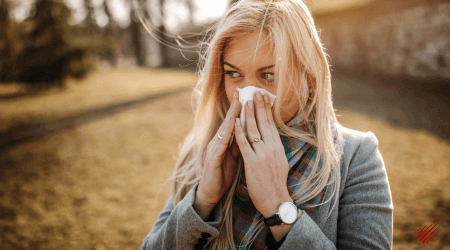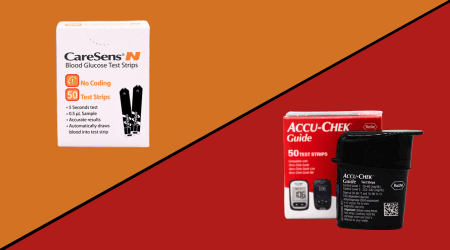
Managing Fall Allergies: Tips for Relief this Season

For those with seasonal allergies, the arrival of fall brings falling leaves, cooler weather, and unfortunately - new allergy triggers. Read on for tips from medical experts on managing fall allergy symptoms.
Overview
- Understand common fall allergy triggers
- Reduce exposure to allergens
- Take over-the-counter medications
- See an allergist for testing and treatment
Understand Common Fall Allergy Triggers
According to the American Academy of Allergy, Asthma & Immunology (AAAAI), ragweed pollen is the main culprit behind fall allergies for millions (AAAAI 2022). Mold spores also proliferate in the fall. Dust mites in homes can worsen with windows closed.
- Ragweed plants release billions of grains of pollen starting in early fall. The pollen spreads far and wide, triggering allergic reactions. Ragweed thrives in warmer climates and along roadsides and fields. Pollen levels peak in mid-September.
- Mold spores multiply once leaves begin falling and provide nourishment. Mold is present year-round, but thrives in the wet, damp conditions of fall. Mold spores are released and spread by wind.
- Dust mites are microscopic bugs present year-round in most homes. But as windows close with cooler fall weather, exposure to accumulated dust mite debris can increase and cause symptoms. Dust mites feed on dead skin cells that humans and pets shed daily. They thrive in warm, humid environments like beds, fabrics, carpets and stuffed furniture. Their fecal particles and decomposing bodies contain proteins that can trigger allergic reactions in sensitized individuals. Symptoms may include sneezing, runny nose, watery eyes, and itchiness. Dust mite allergen levels peak in the fall through winter when windows stay closed. Precautions like encasing mattresses and pillows, washing bedding weekly, and using HEPA air filters can help reduce exposure. Removing clutter such as piles of laundry, stored blankets, and excess stuffed toys can also minimize the cozy spots dust mites love. Thorough vacuum cleaning with a HEPA filter model can suck up allergens.
- Other potential fall allergy triggers include insect stings from wasps and yellow jackets, seasonal foods like pumpkin, and chemicals in smoke from bonfires and fireplaces.
Reduce Exposure to Allergens
The AAAAI recommends keeping windows closed, using air conditioning if possible, and staying indoors on dry, windy days to avoid ragweed pollen exposure (AAAAI 2022). Wear a mask when doing yardwork. Shower after being outdoors.
- To reduce mold spore exposure, clean and dry any visible mold in your home. Use exhaust fans and dehumidifiers to maintain low indoor humidity. Check for and repair any leaks that allow mold-promoting moisture.
- For dust mite allergen reduction, encase mattresses and pillows in allergen-blocking covers. Wash bedding weekly in hot water. Limit stuffed furniture and clutter where dust accumulates.
- When pollen, mold and dust mite levels are high, limit time outdoors when possible. Change air conditioning filters regularly. Consider getting an indoor HEPA air purifier.
- Wear a NIOSH-rated N95 respirator mask when doing yardwork or other unavoidable outdoor activities on high pollen count days. Shower and change clothes after coming inside.
- Be aware of cross-reactive foods like melons, squash, and bananas which share proteins with ragweed and may trigger symptoms.
Over-the-Counter Allergy Medication Options
According to Harvard Health Publishing, oral antihistamines like Zyrtec, Claritin, or Allegra can help relieve allergy symptoms like sneezing and itching (2022).
- Oral antihistamines work by blocking histamine, reducing symptoms like sneezing and itching. Popular name brands include Claritin, Zyrtec and Allegra. Effective lower-cost generic versions are also available, such as loratadine, cetirizine and fexofenadine.
- Corticosteroid nasal sprays can relieve congestion and dripping by reducing inflammation. While Flonase is a well-known brand, generics like fluticasone propionate and Oxymetazoline HCl (Afrin) work equally well at a fraction of the cost.
- Saline nasal sprays help flush out mucus and allergens. Lubricating eye drops can provide relief from itchy, irritated eyes when allergens like pollen bother them. Refer to your pharmacist for generic alternatives to brands such as Major or Rugby nasal sprays and lubricating eye drops.
When purchasing OTC allergy relief, consider selecting more affordable generics first. But always read dosing instructions carefully and consult a doctor or pharmacist if needed. The most important thing is finding medications that provide you symptom relief.
See an Allergist for Testing and Treatment
For moderate to severe symptoms, the Mayo Clinic suggests seeing a board-certified allergist for skin prick testing and to discuss prescription medications or immunotherapy (2022). Reducing symptoms can improve quality of life.
Summary
For those who struggle with fall allergies, it's easy to become frustrated with itchy eyes, sneezing fits, and runny noses this time of year. The good news is there are steps to take to minimize symptoms and enjoy the beauty of autumn. Avoiding common allergy triggers as much as possible, using over-the-counter medications for relief when needed, and seeing an allergist for more severe cases can help manage fall allergies. It's hard when all you want is to be outside in the crisp air but allergies hold you back. With the right prevention plan, it's possible to make the most of fall while keeping allergies at bay. Don't lose hope! With a combination of lifestyle changes, OTC drugs and specialized care, fall allergy suffering can be reduced.


